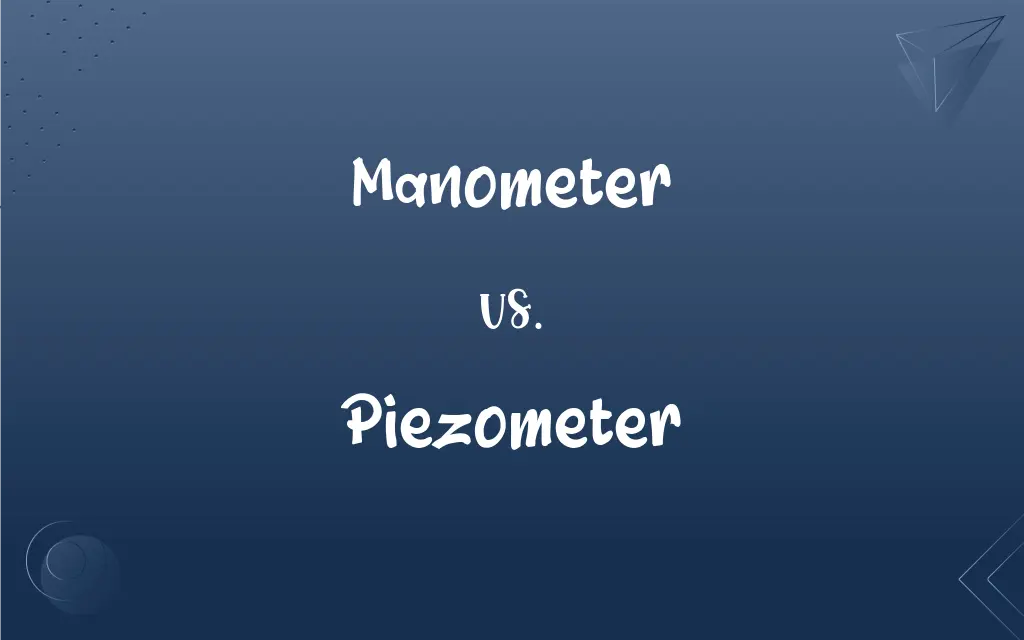Manometer vs. Piezometer: What's the Difference?
Edited by Aimie Carlson || By Janet White || Published on January 5, 2024
A manometer measures pressure difference between two fluids, often using a U-shaped tube, while a piezometer measures fluid pressure in a system, typically groundwater level in a single point.

Key Differences
Manometers and piezometers are both devices used to measure fluid pressures, but they function in different ways and are used in different contexts. A manometer is typically a U-shaped tube filled with a fluid, often mercury or colored water. It measures the pressure difference between two points in a system, which can be a gas or liquid. The pressure is indicated by the difference in fluid levels in the two arms of the U-tube. Conversely, a piezometer is designed to measure the pressure at a single point within a fluid, usually water. It is often used in geotechnical engineering to measure the water pressure in the ground, which is essential for assessing soil conditions and groundwater levels.
The design of a manometer allows it to be very versatile and accurate for a range of pressure measurements. Manometers can be used in laboratory settings, HVAC systems, and industrial processes. Their design varies from simple U-tubes to more complex configurations for specific applications. In contrast, piezometers are simpler in design, consisting of a tube installed in the ground or a water-bearing formation. They are specifically designed to measure the hydrostatic pressure within a fluid, making them invaluable in fields like hydrology, civil engineering, and environmental science.
Manometers provide a visual representation of pressure differences, making them intuitive to use. The height difference of the fluid in the U-tube correlates directly to the pressure difference. This makes manometers particularly useful for applications where real-time monitoring and precise measurements are required. On the other hand, piezometers are typically used where only the pressure at a single point is of interest. They are essential for monitoring groundwater levels, assessing the stability of slopes and embankments, and evaluating the effectiveness of dewatering systems in construction sites.
In terms of operation, manometers can be more sensitive to changes in pressure and can measure both positive and negative pressures (relative to atmospheric pressure). This makes them suitable for a wide range of applications, including testing and calibration of pressure devices. Piezometers, however, are generally used only to measure positive pressure and are most effective in environments where fluid pressure within a material, like soil or rock, needs to be assessed. They are less versatile than manometers but are crucial in their specific field of application.
Comparison Chart
Measurement Focus
Pressure differences in fluids
Static pressure or hydraulic head in fluids
ADVERTISEMENT
Design
U-shaped tubes with fluid
Simple tubes inserted into fluid
Measurement Technique
Based on fluid column height differences
Direct measurement at a single point
Primary Applications
Gas or liquid pressure in various fields
Groundwater levels, soil pressure in geotechnical uses
Accuracy
High accuracy in differential pressure
Accurate in static pressure readings
Manometer and Piezometer Definitions
Manometer
Fluid Column Gauge.
A manometer's fluid levels indicated a pressure imbalance.
ADVERTISEMENT
Piezometer
Single-Point Pressure Checker.
The piezometer provided exact pressure readings at a specific depth.
Manometer
Differential Pressure Indicator.
Differential pressure in the system was measured by a manometer.
Piezometer
Fluid Pressure Gauge.
A piezometer was used to measure static pressure in the soil.
Manometer
U-Shaped Tube Instrument.
The manometer's U-shaped tube showed clear fluid displacement.
Piezometer
Groundwater Level Detector.
Piezometers are essential for assessing groundwater levels in geological studies.
Manometer
Pressure Measurement Device.
The technician used a manometer to check the gas pressure.
Piezometer
Hydraulic Head Measurer.
The piezometer indicated the groundwater's hydraulic head.
Manometer
Engineering Pressure Tool.
Engineers often use manometers for precise pressure measurements.
Piezometer
Geotechnical Instrument.
In the construction site, piezometers monitored the subsurface water level.
Manometer
An instrument used for measuring the pressure of liquids and gases.
Piezometer
An instrument for measuring pressure, especially high pressure.
Manometer
A sphygmomanometer.
Piezometer
An instrument used to measure pressure.
Manometer
An instrument to measure pressure in a fluid, especially a double-legged liquid column gauge used to measure the difference in the pressures of two fluids.
Piezometer
An instrument for measuring the compressibility of liquids.
Manometer
An instrument for measuring the tension or elastic force of gases, steam, etc., constructed usually on the principle of allowing the gas to exert its elastic force in raising a column of mercury in an open tube, or in compressing a portion of air or other gas in a closed tube with mercury or other liquid intervening, or in bending a metallic or other spring so as to set in motion an index; a pressure gauge. See Pressure, and Illust. of Air pump.
Piezometer
A gauge connected with a water main to show the pressure at that point.
Manometer
A pressure gauge for comparing pressures of a gas
Piezometer
A measuring instrument for measuring high pressures
FAQs
How does a manometer work?
It uses fluid columns in a U-shaped tube to indicate pressure differences.
What is the main use of a piezometer?
Mainly used to measure groundwater levels or soil pressure.
Are manometers used for liquid pressure?
Yes, they can measure both gas and liquid pressures.
Is a piezometer used in construction?
Yes, especially in geotechnical engineering for assessing soil conditions.
Can piezometers measure gas pressure?
They're primarily designed for liquids, especially water.
What is a manometer?
A device for measuring fluid pressure, especially for gases.
What does a piezometer do?
Measures the static pressure or hydraulic head in a fluid.
How accurate is a manometer?
Generally very accurate for differential pressure measurements.
Does temperature affect a piezometer's reading?
Temperature changes can influence readings, requiring calibration.
What types of manometers are there?
Includes simple, differential, and digital manometers.
Can a piezometer provide continuous data?
Yes, some models allow for continuous monitoring.
Is a manometer easy to use?
Yes, especially the basic U-tube manometer.
How deep can a piezometer measure?
It varies, but some can measure several meters deep.
Can a manometer detect leaks?
Yes, by measuring pressure differences accurately.
What fluid is in a manometer?
Commonly mercury or colored water.
How is a manometer calibrated?
By setting it to known pressure values and adjusting accordingly.
What maintenance does a piezometer require?
Regular checks for accuracy and potential clogging in the tube.
Can piezometers measure flow rate?
No, they measure pressure or hydraulic head, not flow rate.
Are piezometers used in environmental studies?
Yes, for monitoring groundwater and environmental conditions.
Can manometers measure high pressures?
Depends on the type, but some are designed for high-pressure systems.
About Author
Written by
Janet WhiteJanet White has been an esteemed writer and blogger for Difference Wiki. Holding a Master's degree in Science and Medical Journalism from the prestigious Boston University, she has consistently demonstrated her expertise and passion for her field. When she's not immersed in her work, Janet relishes her time exercising, delving into a good book, and cherishing moments with friends and family.
Edited by
Aimie CarlsonAimie Carlson, holding a master's degree in English literature, is a fervent English language enthusiast. She lends her writing talents to Difference Wiki, a prominent website that specializes in comparisons, offering readers insightful analyses that both captivate and inform.






































































